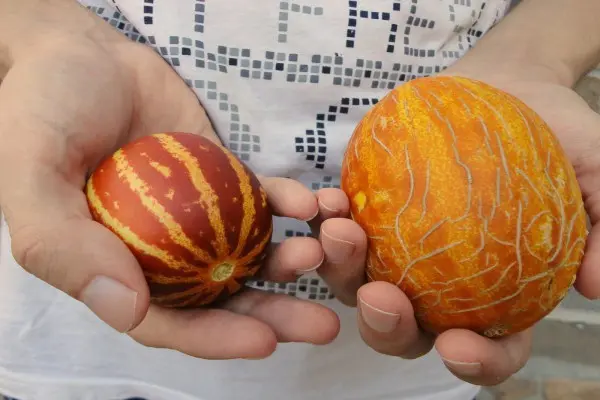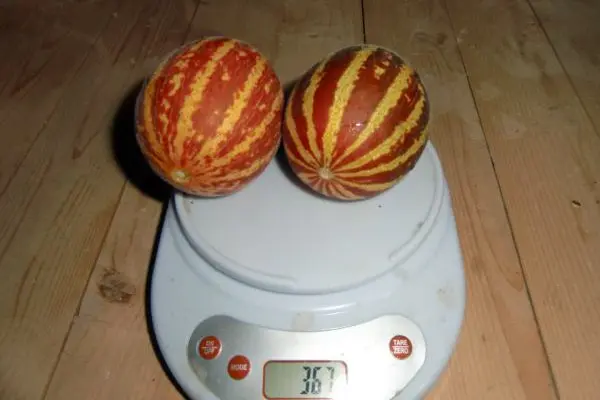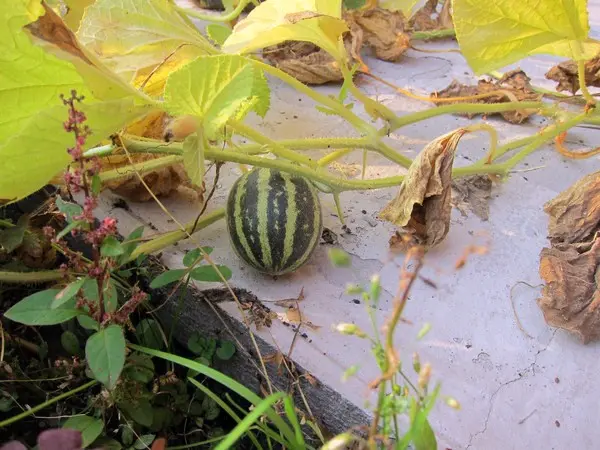Contents
Vietnamese melon is one of the many types of melons in the gourd family. At first, the growth area was only in Asia Minor and Central Asia, but then, thanks to travelers, it expanded to all corners of the world. In this article, we will look at how this species differs, why gardeners are so fond of, and also how cultivation goes.
Description
The Vietnamese melon variety is early ripening, heat-loving and does not tolerate high humidity. The fruits are pumpkins, small, oval, weighing up to 200 g. The small weight of the fruit is compensated by the fact that up to 30 pumpkins can be harvested per season. The peel of the fruit is orange with light yellow stripes, and the flesh is light orange, sweet and slightly oily. There is also a strong sweet aroma of fruits.

The pulp contains a rich set of useful trace elements and vitamins. So, for example, while enjoying the juicy pulp, you saturate your body with potassium, sodium, chlorine, B vitamins (B1, B2), vitamin C, A. In addition, this variety is rich in iron, so Vietnamese melon is included in the diet for anemia, exhaustion, atherosclerosis. Also, this vitamin cocktail has a positive effect on the functioning of the gastrointestinal tract and the urinary-genital system.
Reasons for popularity
The main reason for the popularity of Vietnamese melon lies in the peculiarities of cultivation and vegetation.
For the regions of the middle and northern strip, the choice of varieties is not very rich due to the climate. Early-ripening varieties do not tolerate changes in air temperature very well, late-ripening ones fall during the first frost. It turns out that melons have to be grown either in greenhouses or in heated greenhouses, which is not always convenient and cost-effective.
Vietnamese melon feels great in such conditions, especially if there is no stagnant water on the site. Small fruits ripen quite quickly, do not burden the stems. Moreover, their vegetation does not slow down from the temperature difference, which makes them more resistant to many diseases.

In addition, the short period of fruit ripening makes the Vietnamese variety more profitable to grow – while one pumpkin of the usual variety ripens, the Vietnamese one brings a dozen.
Subtlety of cultivation
The cultivation of the variety is mainly in the southern regions. The main reason for this zoning is that the sweetness of gourds depends a lot on the climate and weather during the season. However, avoiding the machinations of the weather is quite easy – you can grow a melon in a greenhouse.
In fact, agricultural technology repeats the process of growing cucumbers in a greenhouse. When the first ovaries appear, the shoots stepchild.
When growing in a greenhouse, it is not recommended to plant plants densely: there should be 50 centimeters between them in the garden, while between rows – 70 centimeters. But when cultivating them in the open air, the distance should be 70 x 70 centimeters.
Experienced gardeners recommend pinching a Vietnamese melon before the 3rd true leaf, forming two shortened lashes from the axils of the first and second leaves.

Growing Vietnamese melon involves the formation of a bush to increase productivity. The fact is that the fruits are formed on third-order stems, and the bush needs timely stepsoning in order for the formation of ovaries to accelerate. After the fifth true leaf appears, the stem must be pinned (with your hands or scissors) over the third leaf. A similar procedure should be repeated from time to time: as soon as new lashes appear, one is removed, and the rest are stepchildren.
New whips are female flowers that, after pollination, will form ovaries. Wait until they grow to 3-4 centimeters, and then cut off all the small ones, leaving only 5-6 of the largest stems. After 13-14 days, repeat pinching again. Such simple actions will help speed up the growing season and make the plant healthier. But when growing Vietnamese melon in the open field, pinching is carried out over the second, and not the third leaf, in order to grow it in two lashes.
Melons should be grown on highly fertile soils, which will provide the plant with good nutrition with nutrients. Loamy and loamy soil types are best suited, in which organic fertilizers must be applied. For example, for 1 square meter of loamy soil, you will need 6 kilograms of humus.
A few words about planting seedlings. You can plant it only after the frost has passed. The neck of the stem in the root zone can not be sprinkled with earth. Do not replant the plant from place to place.

Care
Although drought tolerant, melons still require regular watering in the first decade of their growth.
When watering, it is important to consider two things:
- Water should not stagnate in the garden. This will negatively affect both the ripening fruits and the bush itself.
- The water must be warm. Watering with cold water will lead to disruption of vegetation, rotting of the roots and will stimulate the development of fungal diseases.
Approximately every two weeks, the beds need to be fed by introducing a solution of ammonium nitrate (25 grams), superphosphate (40 grams), potassium sulfate (15 grams) during irrigation. Before flowering, fertilizing with nitrogen and potassium performs well.
Timely pinching and processing cuts will help not only speed up the growing season, but also protect the melon from diseases.
Also, before flowering, it is necessary to carry out preventive treatments of plants and soil with fungicides and insecticides. Among the diseases and insects to which the culture is most susceptible are: peronosporosis, fusarium, black melon aphid, spider mite.
At the first signs of fungal diseases, it is necessary to treat the bushes with a solution of potassium permanganate (1,5 grams per 10 liters of water). Attracting ladybugs, sowing chamomile, dill, nasturtium helps against insect pests.
Video “Vietnamese decorative melon”
This video, among other things, tells about a rare type of gourds – Vietnamese ornamental melon.









